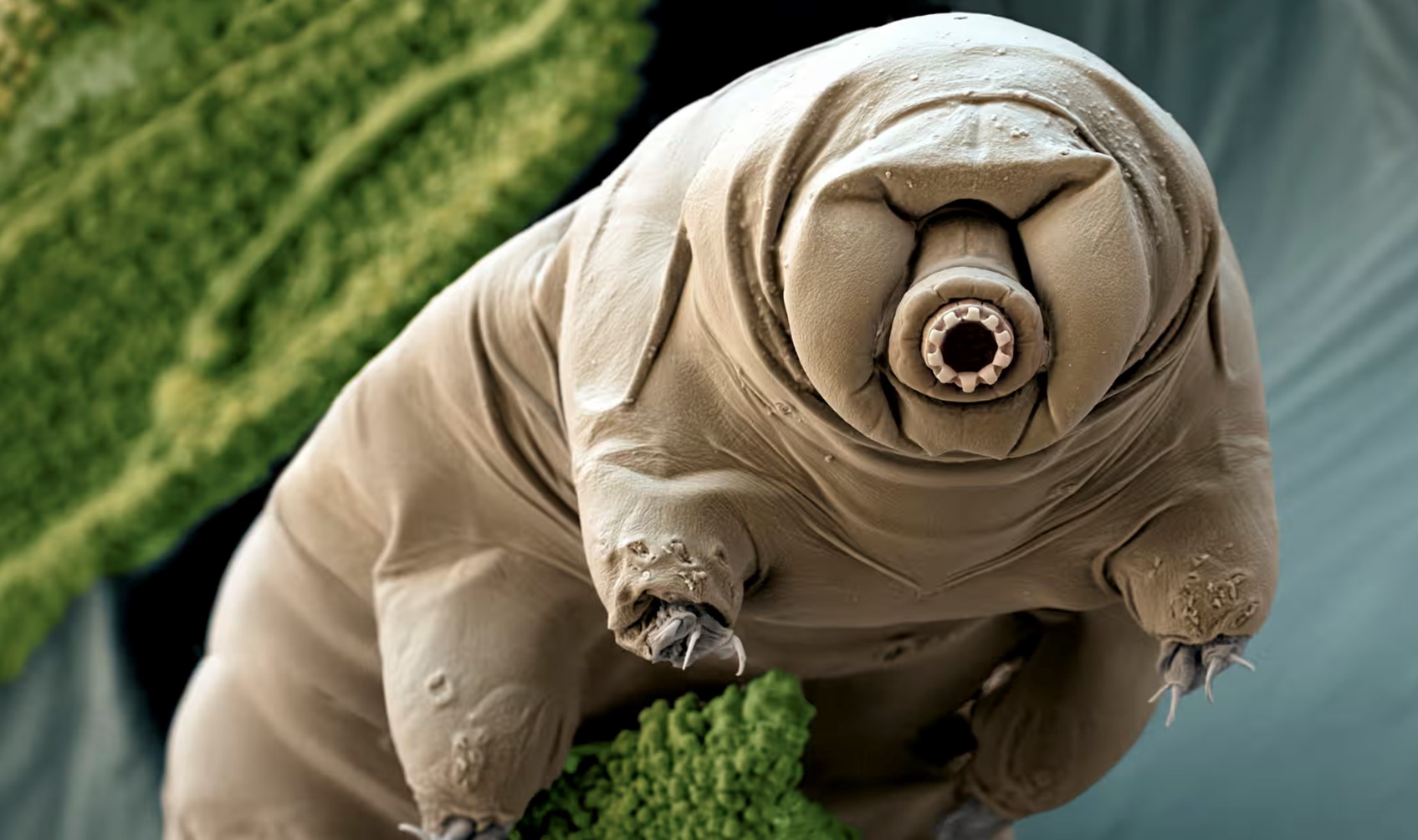
Credit: Eye of Science/Science Photo Library, via the Guardian
Background
Synopsis: Tardigrades, also called water bears or moss piglets, are microscopic organisms found in diverse habitats, including land, freshwater, and saltwater. Known for their extraordinary ability to survive extreme conditions, they are a subject of intense study by scientists worldwide. Their resilience offers insights into biology, with potential applications in medicine and technology.
- Tardigrades, also referred to as water bears or moss piglets, are fascinating micro animals known for their remarkable adaptability. First discovered in 1773 by German zoologist Johann August Ephraim Goeze, they were nicknamed “little water bears” due to their shape and slow movement. Three years later, Italian biologist, Lazzaro Spallanzani named the group “Tardigrada,” meaning “slow stepper.”
- Today, over 1,300 species of tardigrades have been identified with more waiting to be discovered. These microscopic creatures have carved a unique niche in the animal kingdom, and the hunt is on to discover more.
- Physical Characteristics
- Size: Tardigrades measure between 0.002 to 0.05 inches (0.05 – 1.2 mm), with most being no larger than 0.04 inches (1 mm). They are roughly the size of a dot on a page.
- Body Structure:
- They have segmented bodies, flat heads, and eight legs. Depending on the species, each leg has 4-8 claws.
- Unlike vertebrates, tardigrades lack bones or a spine. Instead, their body is supported by a fluid-filled compartment called a hemolymph.
- The tardigrade body possess approximately 1,000 cells, a stark contrast to the trillions of cells found in the human body.
- Internal Systems:
- Tardigrades have a complete digestive system, including a mouth, esophagus, stomach, and anus.
- They have a brain, nervous system, and muscles, but lack a circulatory or respiratory system. Instead, nutrients and gases are transported through an open hemocoel (body cavity), with muscles aiding in the movement of fluids.
- Habitats and Feeding Habits
- Where They Live:
- Tardigrades thrive in aquatic environments, from the great depths of the ocean to the thin water film on mosses and lichens.
- They can also be found in extreme locations, such as the Himalayas at altitudes of 19,600 feet (6,000 meters).
- Diet:
- Using a needle-like tongue, they pierce plants or algae to extract fluids.
- Some species are carnivorous, preying on nematodes, rotifers, or even other tardigrades.
- Reproduction
- Many species of tardigrades are parthenogenetic, able to produce eggs without mating.
- A few other species have been identified as hermaphroditic, able to self-fertilize.
- With these adaptations, many lone tardigrades can establish an entire population if the proper conditions exist.
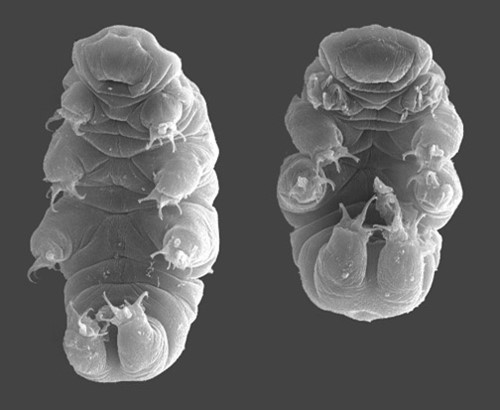
This Hypsibius dujardini is an example of a complex species of tardigrade that is widely used for various research projects pertaining to evolutionary biology and astrobiology.
Credit: Willow Gabriel, Goldstein Lab, CC BY-SA 2.5, via Wikimedia Commons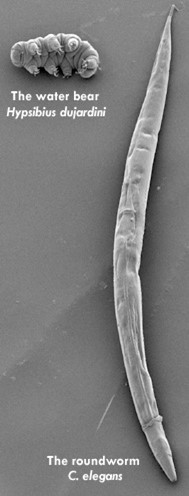
Both the water bear and roundworm (C. elegans) are often used as model organisms in scientific research due to their simple bodies, transparent structures, rapid life cycles, and ability to withstand extremes.
Credit: Bob Goldstein and Victoria Madden, UNC Chapel Hill, CC BY-SA 3.0, via Wikimedia Commons
- Where They Live:
- Tardigrades have many diverse survival mechanisms.
- Under extreme conditions such as dehydration, freezing, or high salinity, tardigrades enter a hibernation-like state called cryptobiosis.
- Anhydrobiosis
- When subject to extreme dry conditions, tardigrades undergo anhydrobiosis resulting in their “tun” form in which they expel up to 95% of their body water, retract their legs and claws, and curl into a ball.
- During this stage, they secrete protective proteins that shield their cells from damage.
- Tardigrades can remain in this metabolic suspension for decades, reviving when conditions improve by rehydrating and returning to normal activity.
- The Space Engineering Research Center (SERC) successfully revived tardigrades from a piece of 100-year-old moss from a museum.
- Cryobiosis
- When subject to extreme cold temperatures, tardigrades either release or generate cryoprotectant agents that manipulate tissue during freezing.
- By slowing down the freezing process, an ice-crystal can form and thaw without causing damage to the body.
- Osmobiosis
- Some tardigrades live in marine environments where they must adapt to changes in salinity. Some go into a tun state similar to anhydrobiosis while others are very efficient in osmoregulation, regulating the balance of water and electrolytes in their bodily fluids.
- Limitations
- Tardigrades cannot withstand water temperatures exceeding 100°F (38°C), which is lethal to them.
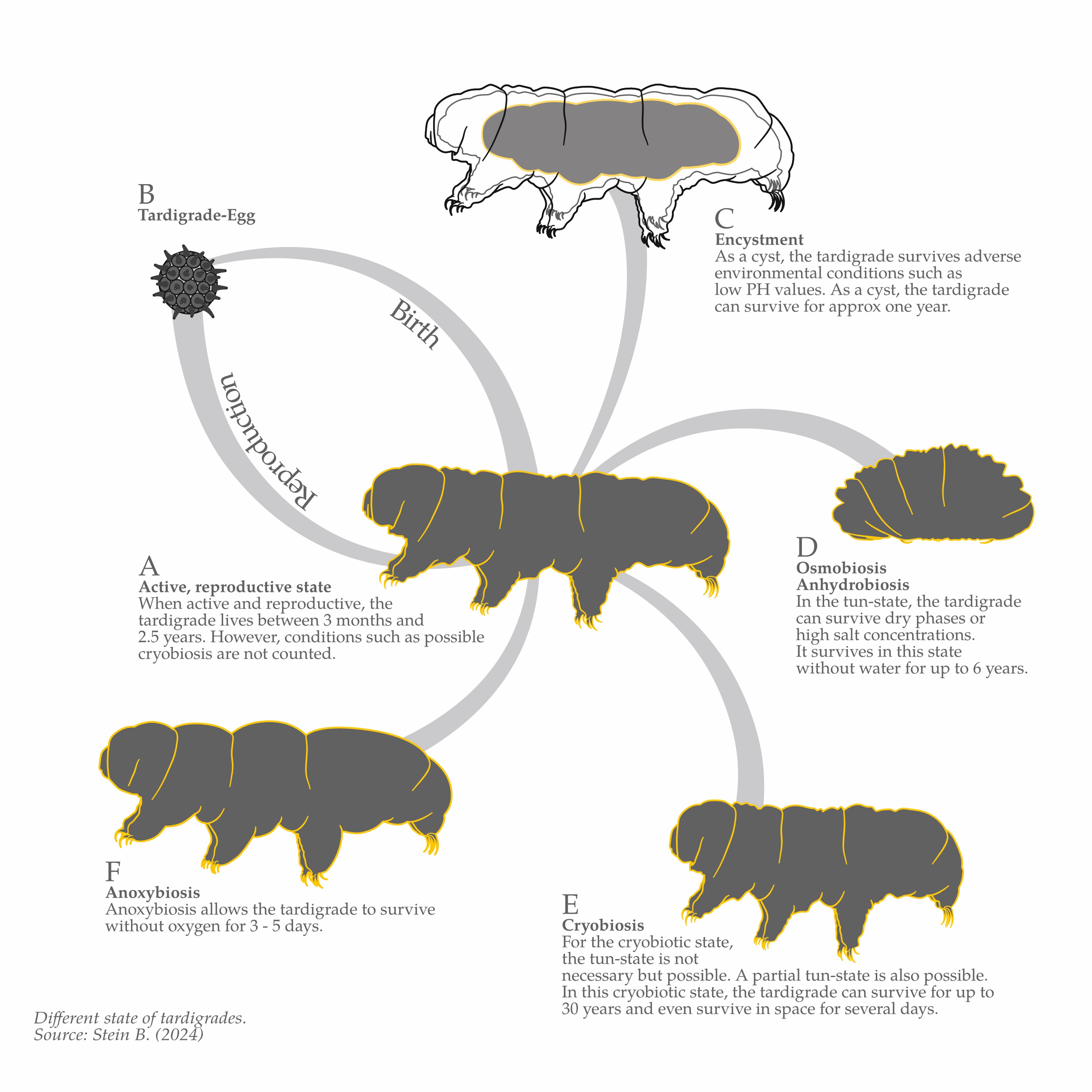
The many different stages of tardigrades. They can survive dry conditions, high salinity, extreme temperatures, and even lack of oxygen.
Credit: Benjamin Stein, CC BY-SA 4.0, via Wikimedia Commons
- Tardigrades cannot withstand water temperatures exceeding 100°F (38°C), which is lethal to them.
- There are only four known fossils of tardigrades, all of which are specimens found in amber, discovered only when paleontologists were looking for other creatures.
- One amber fossil found in Canada was shown to be from the Cretaceous Period, meaning that tardigrades survived the last major extinction that caused the end of the dinosaur era.
- Another sample of amber found in the Dominican Republic dates to the Cambrian Period, more that 500 million years ago.
- These discoveries provide proof of the resilience of these tiny creatures.
- Scientists are exploring how the unique survival mechanisms of tardigrades could lead to breakthroughs in medicine and biotechnology.
- One recent study explored in more detail how tardigrades can resist the effects of radiation.
- Researchers identified the complete genome for a newly found species of tardigrade found in China’s Henan province that consisted of 14,701 genes, 30% of which were unique to this H. henanensis.
- They found that 2,801 of these genes were active for DNA repair, cell division, and immune responses after they were subjected to radiation levels ranging from 200 – 2,000 grays. This dosage is well above what humans could survive.
- The study authors are hopeful that this research may benefit patients undergoing radiation therapy by mimicking the tardigrades’ stress tolerance to radiation.
- Another trait is the tardigrades’ ability to block ultraviolet radiation.
- Using the Paramacrobiotus genus, scientists observed that tardigrades would exhibit biofluorescence in the presence of UV light. This would create a protective shield from the UV light.
- Researchers are studying the unique protein shields formed during cryptobiosis, which could lead to innovations like dry vaccine storage—a game changer for regions lacking refrigeration yet in need of stable vaccines.
- Mimicking the tardigrade's ability to freeze and thaw could improve organ transplantation, extending organ viability and reducing waste.
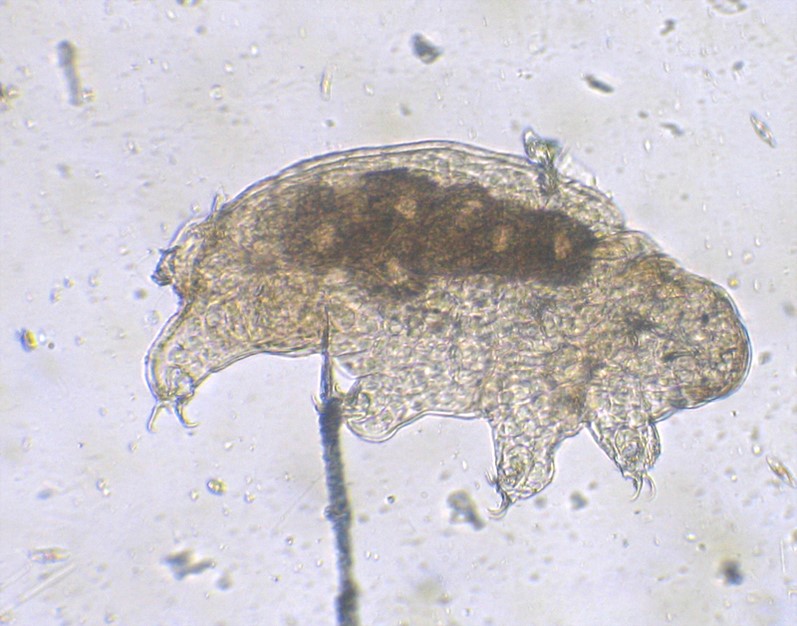
This tardigrade viewed with the aid of a microscope has visible eggs within its hemocoel or body cavity.
Credit: Tommy from Arad, CC BY 2.0, via Wikimedia Commons
- One recent study explored in more detail how tardigrades can resist the effects of radiation.
- If you have a microscope, give water bear hunting a try!
- Tardigrades can be seen with the help of a standard microscope and be found on samples of readily available moss and lichens. Try to spot one using these steps:
- Collect a dry or wet clump of moss or lichen and place in a Petri dish or similar shallow dish.
- Soak in rainwater or distilled water for 2-24 hours.
- Remove the moss or lichen and discard the excess water.
- Shake or squeeze the moss or lichen clumps over another Petri dish to collect the water from the clumps.
- Examine the water using a stereo microscope, starting with a low objective lens.
- If you spot a tardigrade, use a micropipette to transfer it to a microscope slide where it can be observed under higher resolution with a compound microscope.
Episode script
Water bears are so hardy that researchers are studying them to try to advance human medicine.
Scientifically they’re called tardigrades. There are over a thousand species living in wet environments, from the deep sea to moss beds in the Himalayas.
They may look like bears, but there’s no relation. To begin, they’re microscopic, usually less than a millimeter in length.
They have a digestive tract, but no bones, lungs or circulatory system. Their bodies keep their shape by holding fluid within – like a water balloon.
If the tardigrade’s watery home dries up, it dries up too. It curls up in a ball, shrinks to a third its normal size, and goes into suspended animation…where it can stay for decades until there’s enough water to rehydrate.
If the water freezes, the tardigrade produces proteins to protect itself from ice crystals forming inside its body. It withstands UV exposure by producing its own bioluminescence. It endures high levels of radiation with genes that regenerate cells.
Qualities like these have made tardigrades successful for over 500 million years.
And today, scientists hope to learn from them: how to repair human cells after cancer therapy. How to freeze then thaw organs for transplant. How to make vaccines last without refrigeration.
Many big ideas may come from the tiny, nearly indestructible water bear.

